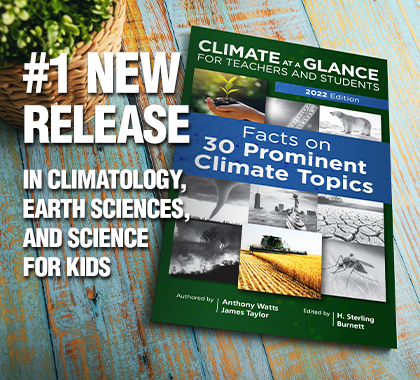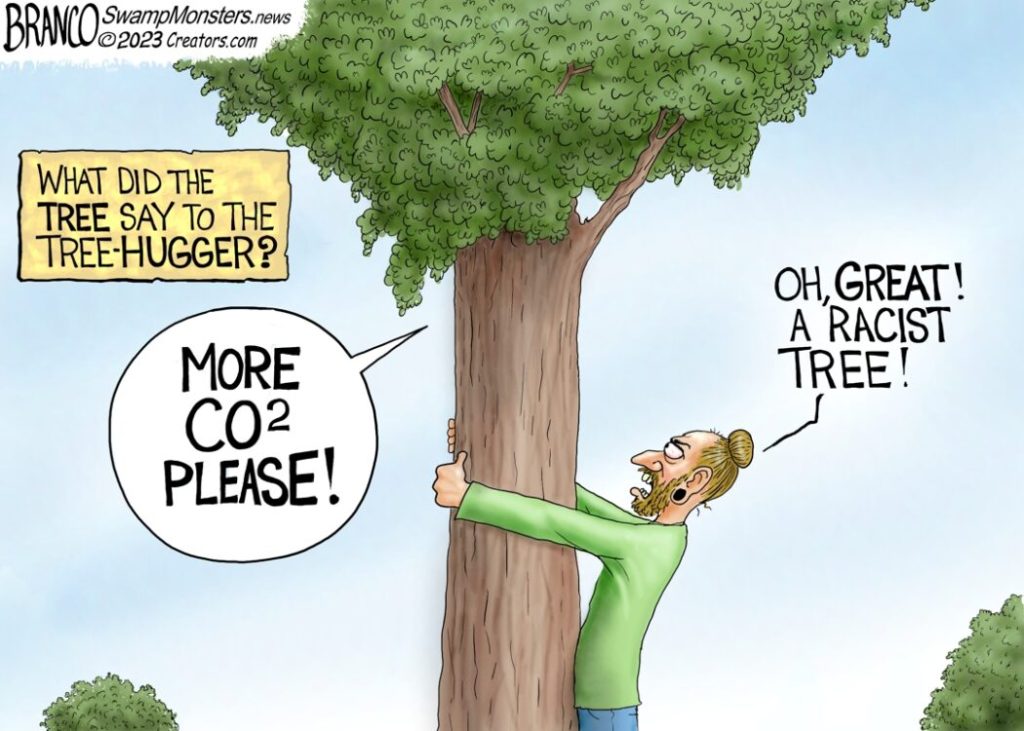YOU SHOULD SUBSCRIBE TO CLIMATE CHANGE WEEKLY.
IN THIS ISSUE:
- Models Can’t Agree on Climate Sensitivity
- Podcast of the Week: This New Film Challenges the Climate Orthodoxy Failure
- Statistics Norway Casts Doubt on CO2 Temperature Driver Claims
- Renewable Power Makes Electricity More Expensive
- EVs Becoming Uninsurable
- Video of the Week: Hottest Summer Ever? NOT!
- Climate Comedy
- Recommended Sites
Miss Anything at Heartland’s Climate Conference? No Problem.

Models Can’t Agree on Climate Sensitivity

For decades, the public has been told climate researchers understand and have accurately modeled “climate sensitivity,” defined as the average global temperature rise we should expect following a doubling of CO2 concentration in the atmosphere compared to pre-industrial levels.
Yet, climate models routinely run too hot, both hindcasting (unless their outputs or the measured data is adjusted to conform) and forecasting far more warming than is actually measured by surface stations, weather balloons, and global satellites.
New research from Roy Spencer, Ph.D., and John Christy, Ph.D., of the Earth System Science Center at the University of Alabama at Huntsville, published in Theoretical and Applied Climatology, concludes the Earth is not as sensitive to additions of carbon dioxide as has been assumed. Why this problem has persisted is unclear. Perhaps it is because of flawed assumptions about feedback loops, perhaps because almost no models properly conserve energy (a factor Spencer and Christy discuss in detail), perhaps because various other factors mitigating CO2 and impacting temperatures are ignored or inadequately modeled.
The climate sensitivity estimates produced by current climate models range over a factor of three, from 1.8 to 5.6 degrees Celsius, in response to a doubling of atmospheric carbon dioxide. Despite 30 years of refinements and revisions, and multiple iterations and versions of Coupled Model Intercomparison Project models, climate simulations have been unable to significantly close the projected gap or settle on a unified number. As a result, 80 percent of climate models project larger, steeper global warming trends over the past 50 years (since 1970) than actual observations record and trend data reveals.
To try and solve this problem and produce a model that is more useful because it more accurately corresponds to real world data, Spencer and Christy have worked for over a decade to develop a single-dimension climate model which incorporates:
time-dependent forcing-feedback[s] … of temperature departures from energy equilibrium … to match measured ranges of global-average surface and sub-surface land and ocean temperature trends during 1970–2021. In response to two different radiative forcing scenarios, a full range of three model free parameters are evaluated to produce fits to a range of observed surface temperature trends (± 2σ) from four different land datasets and three ocean datasets, as well as deep-ocean temperature trends and borehole-based trend retrievals over land.
Their model produced a climate sensitivity estimate of 1.9℃ in response to a doubling of carbon dioxide concentrations. This is at the low end of the projected range, consistent with observational temperature data and with the projections of a small minority of existing models—models whose outputs are largely ignored as outliers by the IPCC and the most prominent alarmist climate scientists.
Importantly, like existing models, Spencer’s and Christy’s model assumes all of the recent warming has been driven by human carbon dioxide emissions. Yet, as Spencer told Phys.org, “If recent warming is partly natural, it would further reduce climate sensitivity.”
In the end, it seems to me that what Spencer’s and Christy’s work demonstrates most clearly is that those claiming to speak for the science of climate change still know very little about the factors which impact climate sensitivity. Climate models have been specifically developed and designed to produce one significant output: average global temperature. Ignore for the moment the fact that is a made-up metric if ever there was one. If they can’t agree on what that output should be, meaning if there is no certainty or small range for climate sensitivity across climate models, then there is certainly no reason to trust or enact public policies in response to any of the ancillary extreme weather outputs and projections that climate models forecast in response to different emission concentration pathways.
In the end, science hasn’t produced a solid measure of climate sensitivity and what drives it. Science hasn’t produced and modeled concentration pathways that reflect actual emissions. Scientists can’t agree on how various forcing factors, like solar activity, clouds, large-scale ocean currents, and aerosols actually impact temperatures, much less how to incorporate them into climate models. Scientists disagree about how various ecosystems and component parts of them might respond to warmer temperatures and what feedback loops they might produce, contributing to or detracting from general warming. And scientists, frankly, don’t know what features and physical mechanisms might remain unaccounted for, rather than just difficult to model—forcing factors or features that impact temperatures and long-term weather patterns on local, regional, or global scales that remain unknown at present.
With all this in mind, climate science might be better served if climate researchers curbed their very visible hubris and rather than speaking with confidence of an impending climate crisis absent the cessation of fossil fuel use, adopt the humility of Socrates, who is reported to have said that to the extent he was wise it was because he understood how little he actually knew, or, per Einstein, “The more I learn, the more I realize how much I don’t know.” I know the public would certainly be better served if climate scientists, rather than proclaiming the science is settled, would admit there are a lot of unknowns and because the stakes are so high, advised policy makers to proceed with caution, adopting policies that are flexible and allow adaptation in the face of an unknowable future.
Sources: Phys.org; Theoretical and Applied Climatology
Get your Copy at Amazon TODAY!

Podcast of the Week
Newsmax aired a prime time documentary titled “A Climate Conversation,” produced with the help of The Heartland Institute. This documentary cuts through the alarmist rhetoric and propaganda to address straightforward scientific questions. The film serves as a vital tool for reaching individuals who are skeptical of the climate alarmist narrative but have not yet heard the counter argument. While it is persuasive, it remains neither confrontational nor exaggerated. The data is enough.
You can watch the film for free at this link.
Subscribe to the Environment & Climate News podcast on Apple Podcasts, iHeart, Spotify or wherever you get your podcasts. And be sure to leave a positive review!
Statistics Norway Casts Doubt on CO2 Temperature Driver Claims

The 147-year-old Norwegian statistics bureau, Statistics Norway, recent published a report which concluded it was premature to tie present temperature trends, the much-feared global warming, to human carbon dioxide emissions.
Dagbladet, one of Norway’s largest newspapers, described the major findings of the report succinctly, writing:
A recent SSB (Statistics Norway) report claims that climate research operates with too short time intervals to be able to determine whether the influence of CO2 on temperatures has a statistical correlation. Other factors such as cloud formation, solar activity, and ocean currents have a significant impact, the researchers claim.
Indeed, the abstract largely speaks for itself:
Weather and temperatures vary in ways that are difficult to explain and predict precisely. In this article we review data on temperature variations in the past as well as possible reasons for these variations. Subsequently, we review key properties of global climate models and statistical analyses conducted by others on the ability of the global climate models to track historical temperatures. These tests show that standard climate models are rejected by time series data on global temperatures.
The Statistics Norway paper points out huge gaps in the climate models, like their inability to account for forcing factors beyond carbon dioxide (which they are tuned for), like water vapor, solar activity, internal natural variation based on large-scale periodic shifts in oceanic and atmospheric currents and activities, and other stochastic, seemingly chaotic and unpredictable occurrences, which have historically affected temperatures across different time scales.
The statistical methods and analysis used by Statistics Norway strongly suggests these factors likely play a much more significant role in present temperatures and temperature trends than is assumed in climate models or understood by the Intergovernmental Panel on Climate Change. Why? Because the analysis shows that temperature variations over various time scales, especially longer time scales, are neither accurately represented by climate models nor explained by assuming carbon dioxide and other trace anthropogenic greenhouse-gas emissions are the sole or even primary factor driving present temperatures.
Others have long pointed out that climate models run too hot and consistently fail to accurately reflect past temperatures when hindcast without significant “homogenization” to force them to match actual measured temperatures. So, Statistics Norway’s statistical analysis is providing independent confirmation of what previous research has indicated about the limits of models. Its analysis goes further, however, by pointing toward specific alternative factors which could be driving temperature changes—factors which open-minded researchers and scientific bodies might think merit further research to determine if better accounting for them could provide an improved understanding of climate change.
This study provides a concise analysis of various factors which have historically impacted temperature variations. It also provides an original statistical time-series comparison of temperature trends—as understood from temperature reconstructions of historical temperatures based on proxy data and, more recently, of temperature data from various modern measurement technologies—and climate model reconstructions which assume carbon dioxide concentrations drive most temperature changes.
Final conclusion:
[R]ecent work on statistical analyses on the ability of the GCMs to track historical temperature data … raise serious doubts about whether the GCMs are able to distinguish natural variations in temperatures from variations caused by man-made emissions of CO2.
Using theoretical arguments and statistical tests we find, as in Dagsvik et al. (2020), that the effect of man-made CO2 emissions does not appear to be strong enough to cause systematic changes in the temperature fluctuations during the last 200 years.
Because this study does not some come from organization that can be portrayed as fringe or funded by interested parties, or a narrow group of climate researchers who can be dismissed (wrongly, of course) as climate deniers, the IPCC and other scientific bodies will have to contend with and take account of this report’s findings going forward when they attempt to make the case for a man-made climate crisis being in the offing.
Sources: Statistics Norway; Dagbladet
Heartland’s Must-read Climate Sites



Renewable Power Makes Electricity More Expensive

Noted British science writer and editor Andrew Montford recently produced a new paper for Net Zero Watch which demonstrates that it is almost an impossibility for new renewable power construction to decrease consumers’ electric power prices.
Net Zero Watch is an organization established to make transparent the economic, political, and normative implications of climate change policies. Montford’s new paper details a series of effects any new windfarm construction imposes on the grid and the types of costs it adds to people’s power bills, which make it virtually impossible that adding any new windfarm to the grid would ever reduce consumer prices.
Montford writes:
In order to reduce bills, a new generator generally has to force an old one to leave the electricity market—otherwise there are two sets of costs to cover. But with wind power, you can’t let anything leave the market, because one day there might be no wind.
[In addition]
Renewables need subsidies, they cause inefficiency, they require new grid balancing services that need to be paid for; the list of all the different effects is surprisingly long. There is only one way a windfarm will push your power bills, and that’s upwards.
Specifically, Montford has identified six distinct ways that adding a new wind farm to an electric grid will add new costs that are almost impossible to offset:
-
- The inefficiency effect
- The capacity market effect
- The levy effect
- Constraints payments
- Artificial inertia
- The transmission effect
The inefficiency effect is the added cost related to the need to switch fuels and operate plants less efficiently, meaning higher costs per unit of energy produced, as new generation, especially subsidized intermittent generation is added to the grid.
The capacity effect is the cost added to get now non-competitive generating units to continue operating rather than shut down to ensure sufficient power is available during emergencies or peak demand.
The levy effect is the actual cost of the subsidies needed to get expensive wind farms built and approved–their capital, legal, and regulatory costs.
The full report is worth reading, so I will forgo summarizing the remaining three cost factors added to residents’ electric bills by new industrial wind facilities.
Overall, Montford estimates that, through the six effects, the U.K.’s push for wind has added between £22.9 billion and £24.5 billion to household energy costs in aggregate, totaling approximately £848 to £850 on average per household.
The wind may free, but harnessing wind power is far from it.
Sources: Net Zero Watch
EVs Becoming Uninsurable
Jonathan Hewett, chief executive of Thatcham Research, which advises automobile insurers in Europe, told The Irish Sun that because it is difficult to establish accurate repair prices for electric vehicles (EVs) for average drivers, the machines are becoming almost uninsurable. Some insurers have stopped offering insurance for EVs altogether, and those that continue to offer coverage are charging very high and rising rates and deductibles for the service.
For even minor damage, EV repair costs are commonly 25 percent more, or greater, than the cost for comparable damage to a gasoline-or-diesel-fueled vehicle.
“What we’re struggling to understand at the moment is how we approach that diagnostic technique,” Hewitt said. “It’s like a doctor trying to understand what’s wrong with you without any notes or an X-ray.
“The challenge is that we have no way of understanding whether the battery has been compromised or damaged in any way,” said Hewitt. “The threat of thermal runaway means that a catastrophic fire could take place if the cells of the battery have been damaged in a collision.”
After even minor accidents, EVs are routinely being written off as total losses because of the cost and complexity of diagnosing possible battery damage and fixing their batteries.
As a result of these difficulties, some insurers have stopped covering electric vehicles entirely.
The Association of British Insurers reports EV repair costs rose 33 percent in the first quarter of 2023, leading to record high annual premiums. Indeed, The Irish Sun reports “electric car insurance costs rose 72 per cent in the year to September, compared to 29 per cent for petrol and diesel models.”
Part of the high insurance costs stems from the fire risk, with repair shops being told to keep any EVs stored on their lots a minimum of 50 feet away from other vehicles and structures.
Looking ahead, The Irish Sun reports, “Thatcham Research said insurers would have to spend an additional £900 million a year on quarantine facilities for damaged cars to meet the required safety measures by 2035.”
Source: The Irish Sun
Video of the Week
On Climate Change Roundtable, we take a stand against selective information portrayal, examining the contexts often omitted in mainstream climate discussions. This week, we’re covering the go-to media hottest ever narrative parroted after every summer. And, we’ll have special guest Marc Morano on to discuss Mann’s court appearance in the decade old Mann vs Steyn case this week.
Tune in every Friday at 1 p.m. ET to watch the Climate Change Roundtable LIVE on The Heartland Institute’s YouTube Channel, and also on Rumble.




























